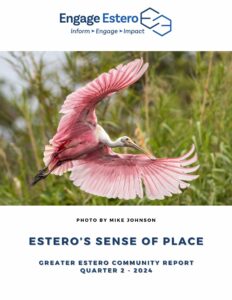
Latest News on the Bicycle and Pedestrian Master Plan
Inspired by Estero residents and other stakeholders, a steering committee convened last October to begin the preparation of the very first Village of Estero Bicycle and Pedestrian Master Plan. The vision of the plan is Walking or riding a bike in the Village of Estero should be a comfortable, convenient, and safe transportation choice for people of all ages and abilities.
The overarching goal is to serve all ages and all skill levels, from our youngest to oldest residents, to increase safety and comfort on our Village’s roads and sidewalks. Safety is paramount; therefore, it is important to keep bike paths separate and apart from auto transportation. The master plan is intended to identify where biking and walking can be established without interfering with auto traffic.
Funded by the Lee County Metropolitan Planning Organization (MPO), the budget for the plan was set at $100,000. After a selection committee comprised of MPO staff, Estero staff, and other stakeholders determined the goals for the study, MPO sent the scope of services to five qualified engineering firms, and the committee selected Jacobs Engineering.
Seven months and many meetings later, Jacobs Engineering is preparing the final Master Plan to present to the community.
Who is Involved?
As described on their website, the Lee County Metropolitan Planning Organization (MPO) is responsible for transportation planning in the Cities of Bonita Springs, Cape Coral, Fort Myers and Sanibel, the Town of Fort Myers Beach, the Village of Estero, and unincorporated Lee County.
Jacobs Engineering has extensive experience in preparation of bicycle and pedestrian master plans for communities like Charlotte County-Punta Gorda, the City of Cape Coral, the Town of Fort Myers Beach and the Metropolitan Planning Organization (MPO).
Estero Staff and the Project Advisory Committee (PAC) have played integral roles in the process, in collaboration with the MPO and the community to provide the foundation for the long-range master plan. Village of Estero Public Works Director David Willems has been involved since the beginning of the process and will serve as project manager once the final plan has been approved.
The Community has been a key feature of the approach since the earliest stages. Public workshops took place in February and March, and Project Advisory Committee meetings were held in early and late March and mid-April. A specialized Wikimap asking for community input garnered more than 1,000 data inputs collected between January 14 through March 8, 2019.
Bike Walk Lee advocate Doug Sexton is one community member involved from the beginning of the process. Serving on the selection committee and PAC, Doug’s priority is safety not only for bikers and pedestrians, but also for drivers.
“If drivers do not have to share a lane with bikers, they have more space,” he explains. “If everyone has their own space, everyone is safer.”
Doug shared that those who attended the public meetings were not just biking enthusiasts – Realtors, members of the Lee County Visitors & Convention Bureau, and people from all walks of life attended.
“Many people are tired of riding around in circles in gated communities,” continued Doug. “Everyone should be able to make a choice about their favorite mode of transportation to get to their destination safely – it’s about quality of life.”
He is of the opinion that if you “build it they will come” and the Village has the opportunity to make Estero a destination for Baby Boomers and young families who want an active lifestyle. “Imagine being able to hop on your bike and take the kids or grandkids out for ice cream.”
He offers solutions done in other communities: 10 to 12-foot shared paths instead of current five-foot paths; protected bike lanes with some type of barrier on high speed roads; and a long-term Rail to Trail option that will take bikers from Estero all the way to Bonita.
He is very pleased with the end result of the report, but is concerned about making the issue a priority for funding.
“We need to invest in our future,” Doug concludes. “We have a great opportunity to make Estero safer with a better quality of life.”

Overview of the Planning Process
One of the first phases of the planning process was to evaluate the Village of Estero’s existing conditions and infrastructure. At this point, our region is used to car traffic, and starting programs for bicycles and pedestrians has only just begun. As it stands now, some areas to dot even have connecting sidewalks. The community is proactive and wants to pursue how we can safely improve this situation.
Currently, there is a total of 39.6 miles of sidewalks in Estero, and 34.1 miles of bike lanes, resulted in 35 percent of Estero roads having sidewalks or bike lanes.
The assessment also determined that almost errands in Estero require a car, giving the Village low marks for a walking score.
The Wikimap was put into place to assess the residents’ input:
The following themes were prominent among people using the Input Map:
- More people commented on biking routes, barriers, and destinations, than for walking
- Most comments focused on major roads (arterials and collectors)
- Many comments on barriers to walking and biking were related to major intersections and entrances to destinations
- People who commented on incomplete routes or routes where pathways abruptly ended felt unsafe and not able to complete their trip within the Village.
What will define a successful plan?
From the Project Advisory Committee (PAC):
- It will allow me to ride from the Preserve at Estero to Publix. (connectivity, safety)
- It will include infrastructure for all kinds of riders, people will have choices
- It will address education – driver/cyclist conflicts
- It will be an implementable plan – not necessarily cutting edge, or trendy
From the community:
- It will allow me to stay in Estero to bike, and will become a destination for others
- I’ll be able to use it – safe and comfortable facilities
- It will increase east-west connections
- It will address education and culture
- It will include pedestrian bridges and longer crossing times for pedestrians
- It will improve intergovernmental coordination leading to implementation and maintenance
Who is concerned?
The next question to be addressed was to determine who the interested parties are.
Data from the PAC:
- People of all ages and abilities.
- Estero is a leisure destination, visitors want to bike to destinations like Koreshan
- Communities connect to schools
- Recreational riders:
- Long-distance cyclists – SunTrail
- Confident road cyclists
- Not-confident cyclists
Data from the community:
- People who bike or walk because they have no choice
- Students
- Retirees
- Recreational riders:
- Long-distance cyclists
- Confident cyclists (sometimes on sidewalks)
- Not-confident cyclists (usually on sidewalks)

The Top Six Goals of the Master Plan
Based on the gathered data and input, the goals include:
- Increase the safety for all users of the transportation network – people walking, biking, accessing transit, and driving vehicles. Reduce the number of crashes involving people walking and biking by half within ten years.
- Increase the active transportation infrastructure. Double the number of miles of safe walking and biking facilities in the Village of Estero within ten years.
- Increase the active transportation options for commuters. Double the share of commuters who choose to walk, bike, and use transit by 100 percent within ten years.
- Complete the Florida SUN Trail link within the Village of Estero by 2030. The Sun City trail link currently encompasses 21 walking or biking trails covering 225 miles.
- Create at least one new educational campaign geared towards improving safety in the Village of Estero within five years of adopting this plan.
- Create at least one new encouragement program to increase the number of people using the active transportation network in the Village of Estero within five years of adopting this plan.
Before identifying the necessary projects to achieve the Plan’s goals, Jacob Engineering measured the priority criteria by identifying gaps against four themes:
Mobility – makes connections or fills gaps
Safety – in an area with safety issues
Connections – access to jobs, schools, parks, destinations
Public Support – which gaps are important to residents
Goal: determine which gaps, when filled, would give the best return on investment
The intensive study and meticulous process enabled the MPO, the engineering firm, the committee, and the community to identify six project areas:
Sidewalks
Intersections
Crossings
Bike Lanes (1.0)
Bike Lanes (2.0)
Shared Use Paths
The team also identified necessary programs and policies to put in place as we move forward:
- Agency/Staff Trainings
- Bicycle and Pedestrian Counting Program
- Expand Open/Active Street Events Programming
- Bicycle Parking Design Standards/ Program
- Local Complete Streets Policy
- Adopt a Route Program
- Bicycle And Pedestrian Route/Wayfinding Program
- Pilot Programs/Tactical Urbanism Projects
- Dedicated County Safety Program/Staff
- Sidewalk infill and ADA program/staff
What happens next?
The seven-month process has yielded invaluable data and vast community input. As a result, the final report and recommendations will be presented to the Village of Estero Council on June 5, 2019 to determine what happens next.


